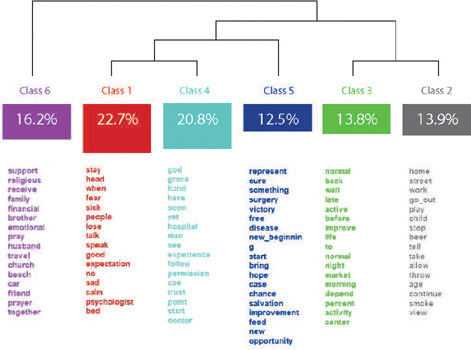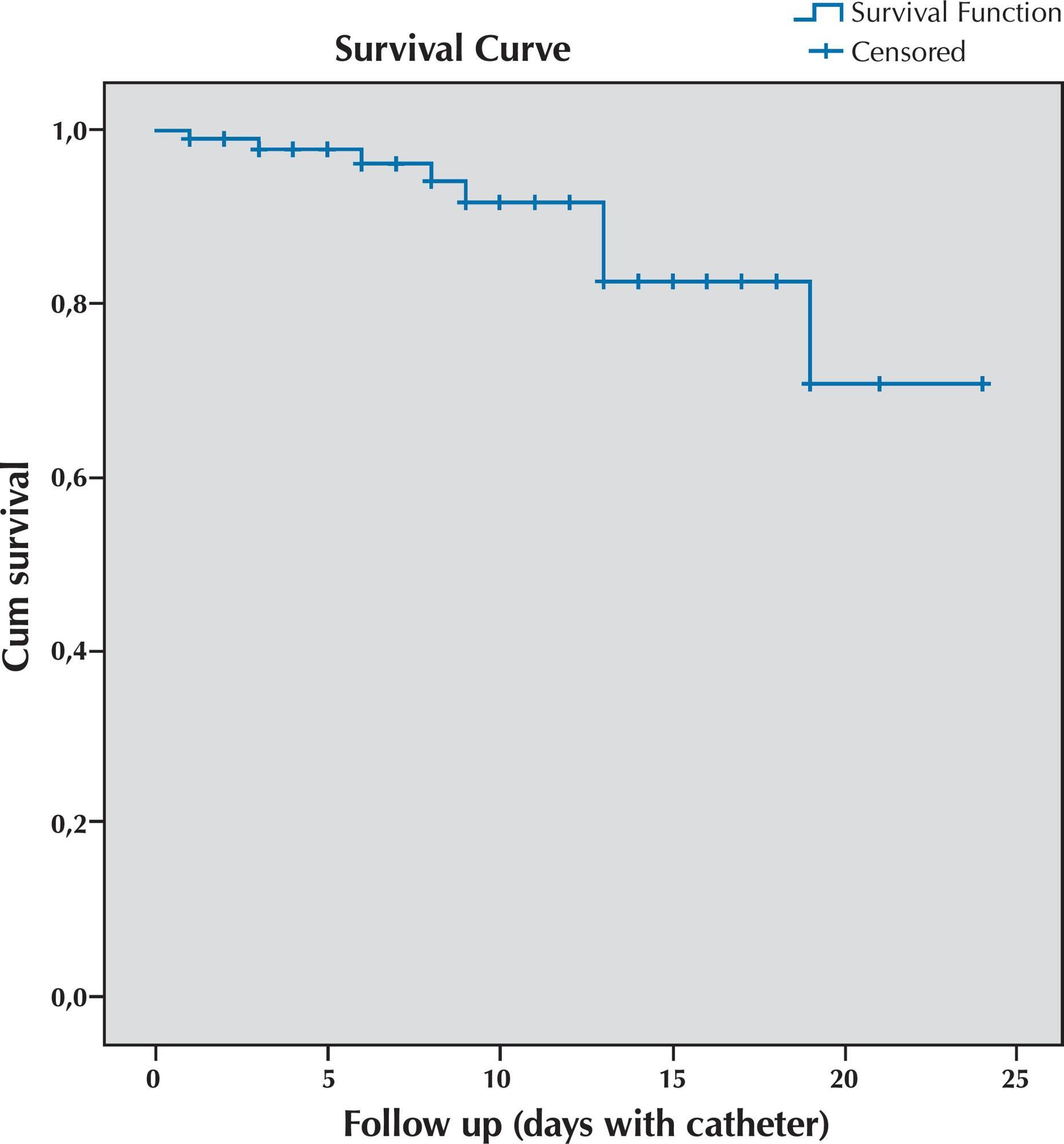-
ERRATUM01-13-2024
ERRATUM
Revista Brasileira de Enfermagem. 2024;77(6):e2024n6e08
Abstract
ERRATUMERRATUM
Revista Brasileira de Enfermagem. 2024;77(6):e2024n6e08
DOI 10.1590/0034-7167.20247706e08
Views0In the article “Brazilian nursing specific situation, middle and micro-range theories: a bibliometric study”, with DOI number: , published in Revista Brasileira de Enfermagem, 2024;77(4):e20230520, Chart 1: Where it read: […]See more -
ERRATUM01-13-2024
ERRATA
Revista Brasileira de Enfermagem. 2024;77(6):e2024n6e07
Abstract
ERRATUMERRATA
Revista Brasileira de Enfermagem. 2024;77(6):e2024n6e07
DOI 10.1590/0034-7167.20247706e06pt
Views0No artigo “Crenças e atitudes de pais ou responsáveis legais sobre a vacinação infantil: revisão de escopo”, com número DOI: , publicado no periódico Revista Brasileira de Enfermagem, 2024;77(4):e20240126, página 5:Onde se lia:[…]See more -
ORIGINAL ARTICLE01-13-2024
Indicators associated with severity and mortality in hospitalized people with HIV: A retrospective cohort
Revista Brasileira de Enfermagem. 2024;77(6):e20240204
Abstract
ORIGINAL ARTICLEIndicators associated with severity and mortality in hospitalized people with HIV: A retrospective cohort
Revista Brasileira de Enfermagem. 2024;77(6):e20240204
DOI 10.1590/0034-7167-2024-0204
Views0See moreABSTRACT
Objectives:
to compare the sociodemographic and clinical severity indicators of hospitalized people with HIV in relation to clinical outcomes and urgent hospital admission.
Methods:
a retrospective cohort study was conducted with 102 medical records of HIV-infected individuals hospitalized in a hospital in southern Brazil. In addition to descriptive analysis, Fisher’s exact test, Pearson’s Chi-square, and logistic regression were used.
Results:
the data showed a significant direct effect on severity indicators in the following variables: male sex (p=0.013), skin color (p=0.023), level of education (p=0.000), urgent admissions (p=0.000), late diagnosis (p=0.001), diabetes mellitus (p=0.001), hypertension (p=0.004), kidney disease (p=0.002), high viral load (p=0.006), CD4+ count below 200 (p=0.005), fever (p=0.016), weight loss (p=0.013), co-infection with hepatitis C (p=0.004), and mortality (p=0.007).
Conclusions:
three sociodemographic and thirteen clinical markers were identified as being associated with the risk of clinical deterioration in hospitalized people with HIV.
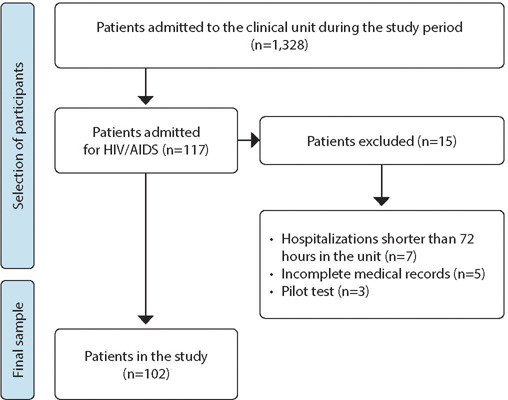
-
ORIGINAL ARTICLE01-13-2024
Nurses’ perspectives on the use of telemonitoring in the management of people with diabetes and hypertension
Revista Brasileira de Enfermagem. 2024;77(6):e20230481
Abstract
ORIGINAL ARTICLENurses’ perspectives on the use of telemonitoring in the management of people with diabetes and hypertension
Revista Brasileira de Enfermagem. 2024;77(6):e20230481
DOI 10.1590/0034-7167-2023-0481
Views1See moreABSTRACT
Objectives:
to understand the perspective of nurses on the use of telemonitoring in the management of people with type 2 diabetes mellitus and arterial hypertension in primary care.
Methods:
this qualitative research involved sixteen nurses from eight municipalities in Paraná. Data were collected between November 2022 and January 2023 through inperson or remote interviews, which were audio-recorded and subjected to content analysis.
Results:
according to the nurses, telemonitoring enhances users’ knowledge about these conditions, communication and connection with the team, and productivity. However, the lack of electronic resources and equipment, high staff turnover, low user adherence, and the limited availability of professional time present significant challenges.
Final Considerations:
the effective implementation and operation of telemonitoring in the management of people with diabetes and hypertension involve both potential benefits and barriers. It is essential to have the availability of human and technological resources, managerial support, and the commitment of professionals and users.
-
ORIGINAL ARTICLE01-13-2024
Knowledge, Attitudes, and Practices of nurses regarding blood culture collection
Revista Brasileira de Enfermagem. 2024;77(6):e20230424
Abstract
ORIGINAL ARTICLEKnowledge, Attitudes, and Practices of nurses regarding blood culture collection
Revista Brasileira de Enfermagem. 2024;77(6):e20230424
DOI 10.1590/0034-7167-2023-0424
Views0ABSTRACT
Objectives:
to investigate the knowledge, attitudes, and practices of nurses regarding blood culture collection.
Methods:
a cross-sectional study was conducted in five Brazilian public hospitals with 112 nurses. Data were collected using an adapted questionnaire and analyzed through descriptive and inferential statistics.
Results:
nurses who did not consider themselves capable of collecting blood cultures had a 72% lower chance of performing the collection at the recommended site and an 83% lower chance of using the same needle for blood inoculation into the vials. Nurses working in the emergency department had a 75% lower chance of knowing the international benchmark for blood culture contamination rates, and those with less than 5 years in the position decreased their chance of accuracy in this matter by 79%.
Conclusions:
there are gaps in the knowledge, attitudes, and practices of nurses regarding blood culture collection. Standardization of the technique, periodic education, supervision and guidance of the collection team, and process auditing are recommended coping strategies.
Keywords:Blood CultureBlood Specimen CollectionHealth Knowledge, Attitudes, PracticeNursing CareQuality of Health CareSee more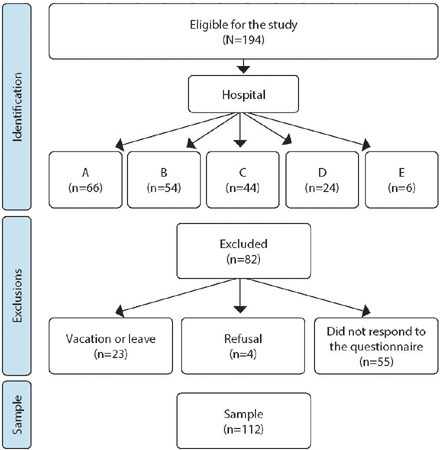
-
ORIGINAL ARTICLE01-13-2024
Evaluation of care for people with HIV in Primary Health Care: construct validation
Revista Brasileira de Enfermagem. 2024;77(6):e20230190
Abstract
ORIGINAL ARTICLEEvaluation of care for people with HIV in Primary Health Care: construct validation
Revista Brasileira de Enfermagem. 2024;77(6):e20230190
DOI 10.1590/0034-7167-2023-0190
Views0ABSTRACT
Objectives:
to verify the construct validation of an instrument for evaluating care for people living with HIV in Primary Health Care.
Methods:
methodological study carried out in 2021 with 260 health professionals in Recife, PE. Validation based on the internal structure was carried out at this stage using exploratory and confirmatory factor analysis, and validity based on item response theory.
Results:
the validation determined the retention of five factors and 63 items. The instrument’s internal consistency and quality of fit was 0.90, the Tukey-Lewis index was 0.915 and the comparative fit index was 0.918 in the confirmatory factor analysis. The indication for the absolute majority of items is adequate fit.
Conclusions:
the instrument has construct validity, making it possible to use it to evaluate the decentralization process and care for People Living with HIV in Primary Health Care.
Keywords:Acquired Immunodeficiency SyndromeComprehensive Health CareHIVPrimary Health CareProgram EvaluationSee more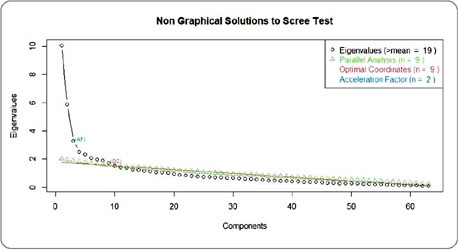
-
ORIGINAL ARTICLE01-10-2024
Inventory of ethical problems in mobile pre-hospital care
Revista Brasileira de Enfermagem. 2024;77:e20230539
Abstract
ORIGINAL ARTICLEInventory of ethical problems in mobile pre-hospital care
Revista Brasileira de Enfermagem. 2024;77:e20230539
DOI 10.1590/0034-7167-2023-0539
Views0See moreABSTRACT
Objective:
to construct and validate the content of an inventory of ethical problems experienced by nurses in mobile pre-hospital care.
Method:
a psychometric approach study, developed with the following stages: (1) instrument construction through a theoretical matrix based on deliberative bioethics, scoping review and online qualitative research; (2) content validity by judges; (3) pre-testing with Mobile Emergency Care Service nurses in various Brazilian states. For content validity analysis, the Content Validity Ratio was calculated (CVR>0.45 for judges and CVR>0.35 for the target population).
Results:
the instrument had 44 items, distributed across four dimensions.
Final considerations:
the constructed instrument presented sources of evidence of content validity, providing good psychometric measurements and constituting a useful tool for nurses’ practice in the pre-hospital setting.
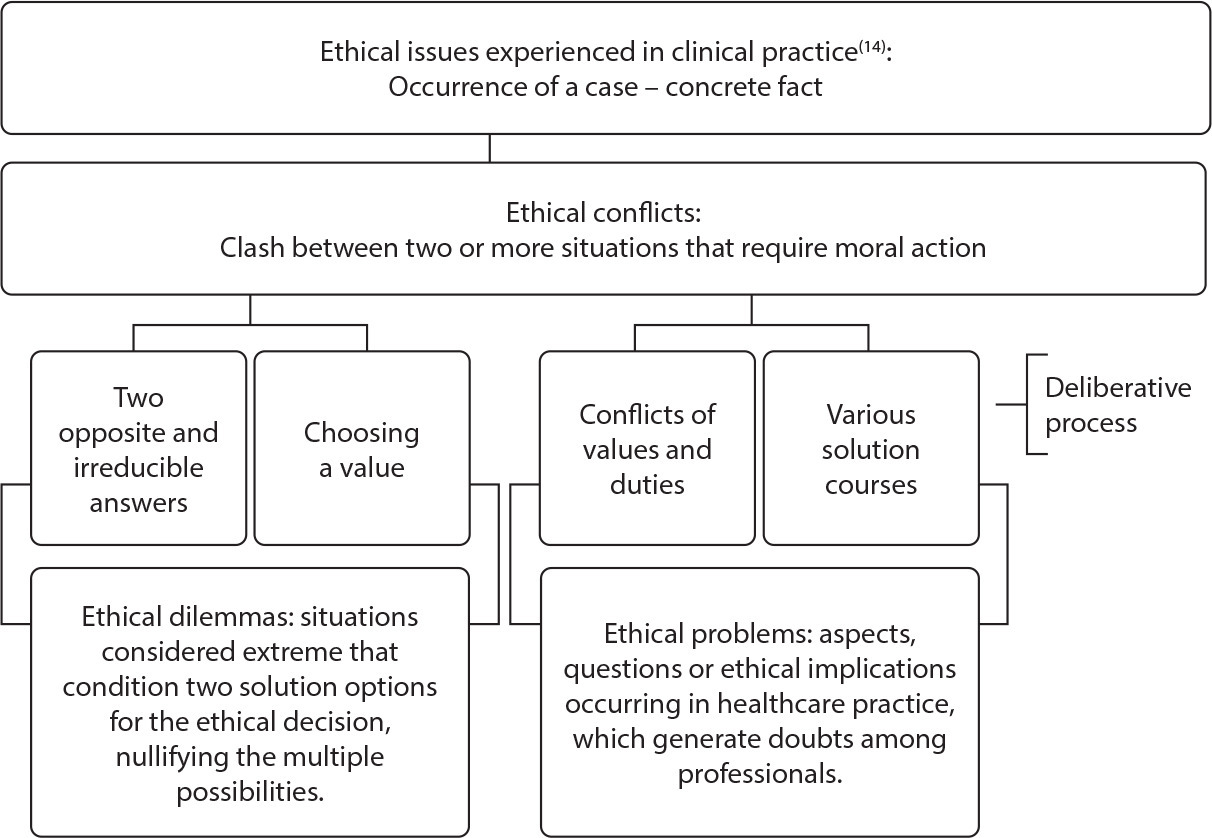
-
ORIGINAL ARTICLE01-10-2024
Childbirth dynamics in the riverside region of the Brazilian Amazon from the perspective of geospatialization
Revista Brasileira de Enfermagem. 2024;77:e20240038
Abstract
ORIGINAL ARTICLEChildbirth dynamics in the riverside region of the Brazilian Amazon from the perspective of geospatialization
Revista Brasileira de Enfermagem. 2024;77:e20240038
DOI 10.1590/0034-7167-2024-0038
Views0See moreABSTRACT
Objective:
to analyze the spatial-temporal pattern of childbirths and flow of postpartum women assisted at a regional reference maternity hospital.
Methods:
ecological study of 4,081 childbirths, between September 2018 and December 2021, at a public maternity hospital in the Baixo Tocantins region, Pará, Brazil. With data collected from five sources, a geographic database was constructed, and spatial analysis was used with Kernel density interpolator. Maps were generated using QGis/3.5 and TerraView/4.3, calculating chi-square (p<0.05).
Results:
the highest concentrations of normal and cesarean childbirths were observed in Barcarena (n=2,558/62.68%), Abaetetuba (n=750/18.38%), Moju (n=363/8.89%) and Igarapé-Miri (n=219/5.37%). Among the municipalities in the region, ten had obstetric beds, totaling 210 beds. In this scenario, postpartum women traveled up to 288 km to reach the maternity hospital.
Conclusions:
long distances between certain municipalities of residence and maternity hospital, and low supply of obstetric beds, were identified as risk factors for unfavorable obstetric outcomes.
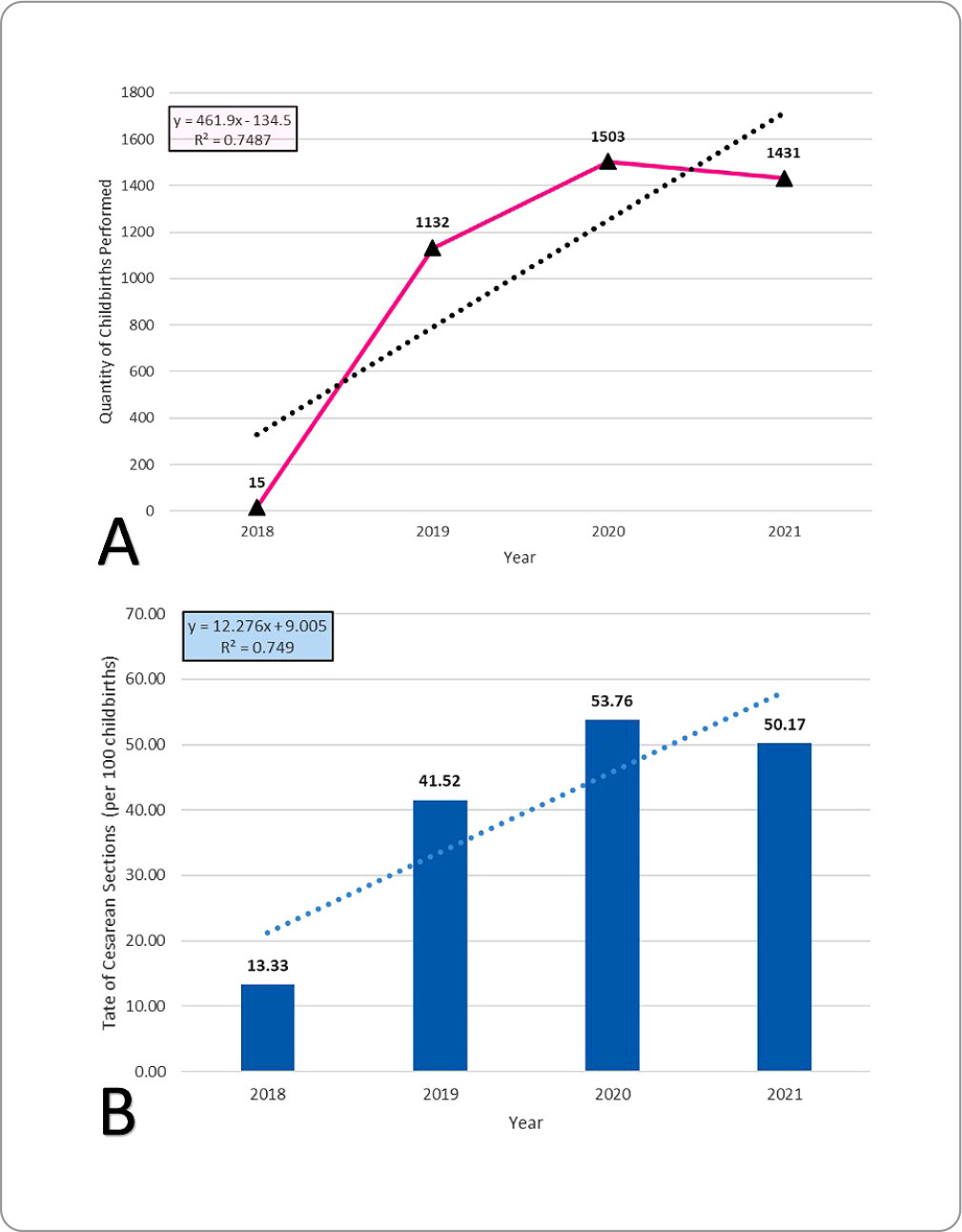
-
REVIEW01-10-2024
Nurses’ practical contributions to improving healthy and sustainable public spaces: an integrative review
Revista Brasileira de Enfermagem. 2024;77:e20240023
Abstract
REVIEWNurses’ practical contributions to improving healthy and sustainable public spaces: an integrative review
Revista Brasileira de Enfermagem. 2024;77:e20240023
DOI 10.1590/0034-7167-2024-0023
Views0ABSTRACT
Objective:
to identify knowledge production about nurses’ contributions to improving healthy and sustainable public spaces.
Methods:
an integrative review carried out in February 2023 in electronic databases. Studies that answered the research question and that were available in full, in Portuguese, English and Spanish, were included.
Results:
a total of five articles were selected. The findings highlighted the importance of educational projects in the training of local managers and community autonomy; citizen participation and health promotion as ways to implement Sustainable Development Goal 11; nurses as facilitators of collective care; new health practices and modes of producing subjectivity; and use of public transportation, bicycles and/or walking in these spaces.
Final considerations:
there is a clear need for greater incentives from local governments to develop effective sustainability strategies that are led by nurses and the community.
Keywords:AttitudesCommunity HealthHealth KnowledgeHealthy Lifestyle, NursesNursesPracticeSustainable DevelopmentSee more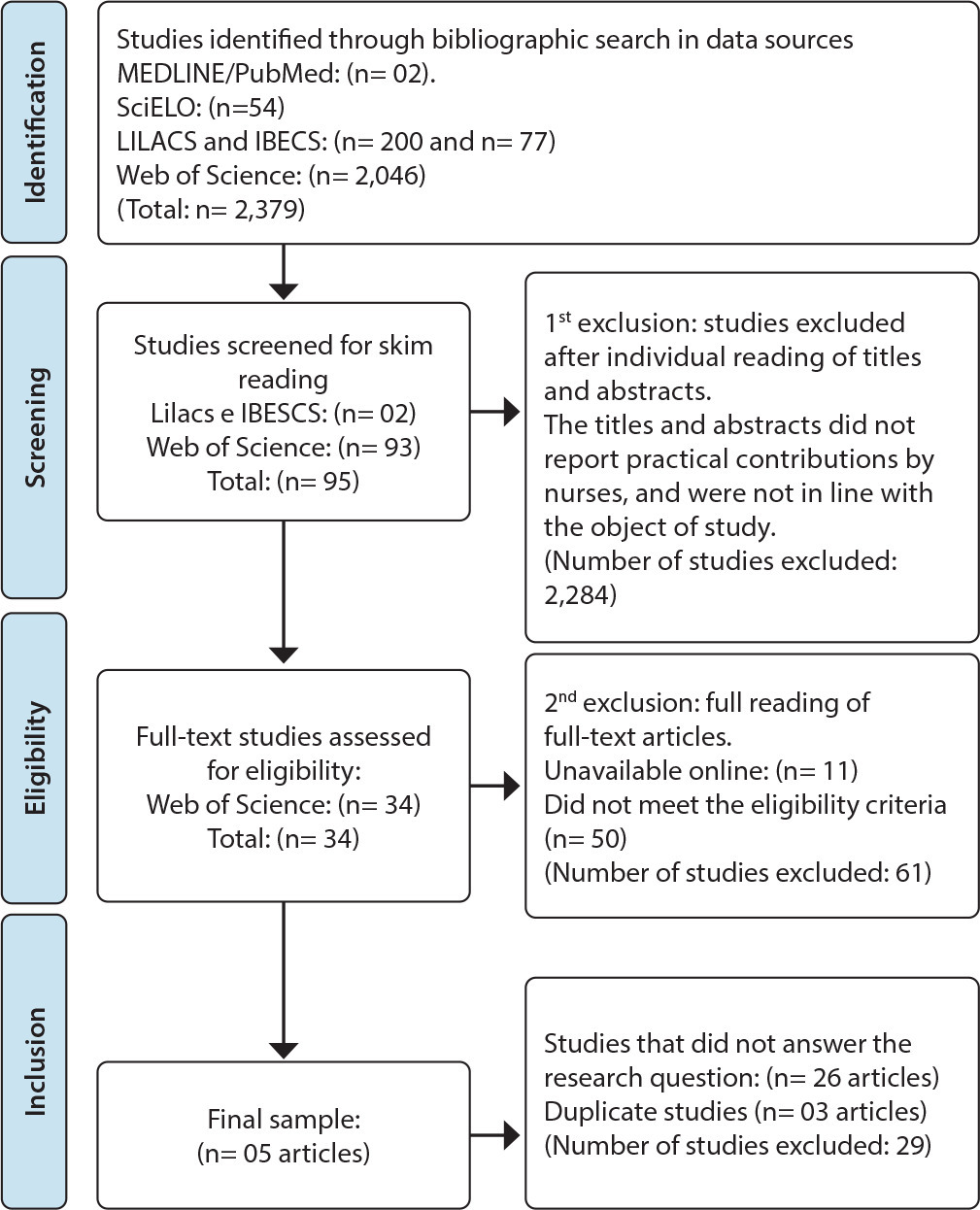
-
ORIGINAL ARTICLE01-10-2024
Pain management in hospitalized infants: recommendations for achieving the Sustainable Development Goals
Revista Brasileira de Enfermagem. 2024;77:e20230421
Abstract
ORIGINAL ARTICLEPain management in hospitalized infants: recommendations for achieving the Sustainable Development Goals
Revista Brasileira de Enfermagem. 2024;77:e20230421
DOI 10.1590/0034-7167-2023-0421
Views0See moreABSTRACT
Objective:
to assess pain management in infants in a Neonatal Intensive Care Unit (NICU) and discuss its articulation with the Sustainable Development Goals, with a focus on promoting neonatal well-being.
Method:
a documentary study, retrospective in nature and quantitative approach, conducted in a NICU of a public hospital in Paraná, Brazil, between January and July 2022, with 386 medical records of infants, hospitalized for more than 24 hours, between 2019 and 2021. Data were subjected to descriptive and inferential analysis, considering p-value<0.05 as a statistical difference. National ethical guidelines were respected.
Results:
all infants underwent at least one painful procedure, but only 13.7% had documented pain. Pharmacological interventions, such as fentanyl (25.9%), and non-pharmacological interventions, such as breastfeeding encouragement (86%) were used. Only 2.8% were reassessed.
Conclusion:
there was a devaluation of neonatal pain management that may perpetuate neonatal well-being and sustainable development.
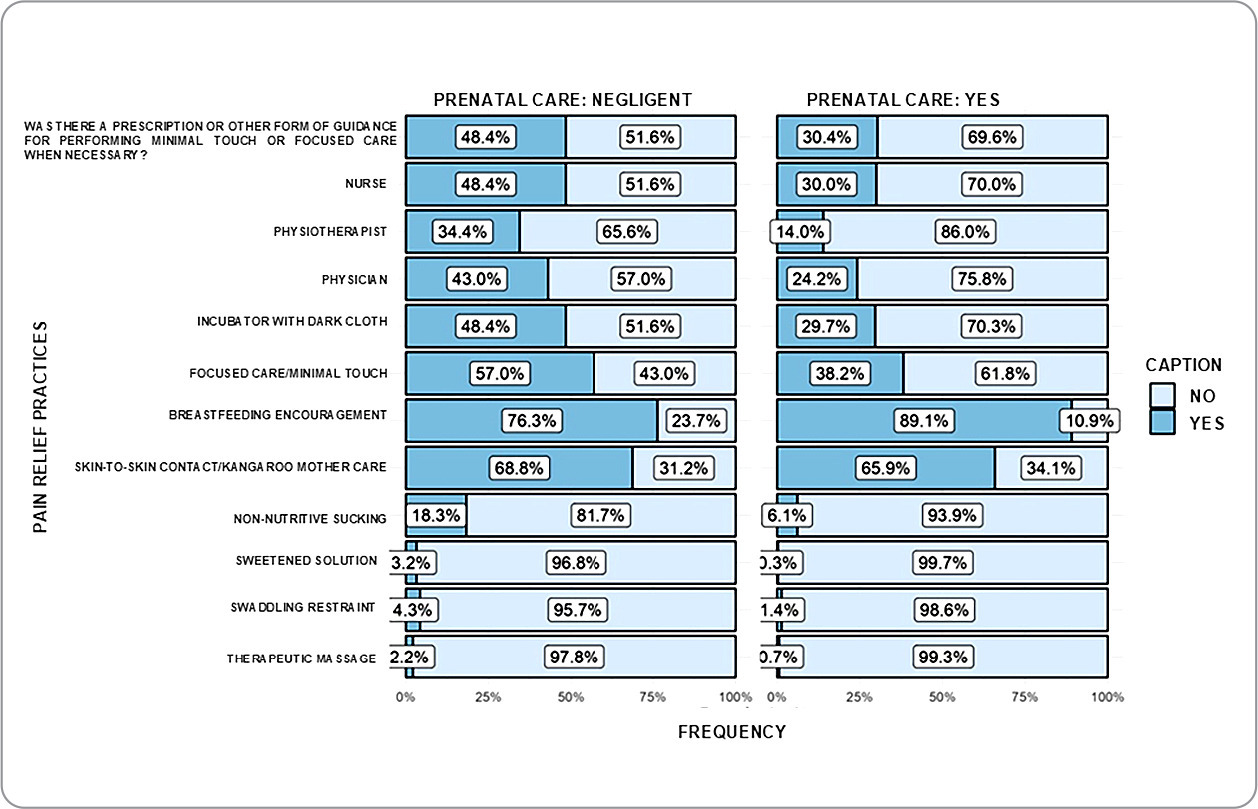
-
LETTER TO THE EDITOR01-10-2024
Adherence to COVID-19 vaccination during the pandemic and fake news: Correspondence
Revista Brasileira de Enfermagem. 2024;77:e202477Suppl101c
Abstract
LETTER TO THE EDITORAdherence to COVID-19 vaccination during the pandemic and fake news: Correspondence
Revista Brasileira de Enfermagem. 2024;77:e202477Suppl101c
-
LETTER TO THE EDITOR01-10-2024
Adherence to COVID-19 vaccination during the pandemic and fake news: Correspondence
Revista Brasileira de Enfermagem. 2024;77:e202477Suppl101c
Abstract
LETTER TO THE EDITORAdherence to COVID-19 vaccination during the pandemic and fake news: Correspondence
Revista Brasileira de Enfermagem. 2024;77:e202477Suppl101c
DOI 10.1590/0034-7167.202477Suppl101c
Views0Dear Dr Dulce Aparecida BarbosaEditor in Chief of the Revista Brasileira de Enfermagem[…]See more -
ORIGINAL ARTICLE01-10-2024
Clinical and epidemiological characteristics and outcomes of patients affected by COVID-19 in the Intensive Care Unit
Revista Brasileira de Enfermagem. 2024;77:e20230527
Abstract
ORIGINAL ARTICLEClinical and epidemiological characteristics and outcomes of patients affected by COVID-19 in the Intensive Care Unit
Revista Brasileira de Enfermagem. 2024;77:e20230527
DOI 10.1590/0034-7167-2023-0527
Views0See moreABSTRACT
Objective:
To understand the clinical and epidemiological characteristics, outcomes, and nursing care of adult patients affected by COVID-19 in the Intensive Care Unit.
Methods:
This is a quantitative, retrospective, and descriptive study. The study participants were clinical and epidemiological statistical reports. Variables analyzed included age, gender, race, comorbidities, signs and symptoms, length of hospital stay, use of mechanical ventilation, medications, infections, monitoring, invasive devices, positioning, diet, comfort, and clinical outcomes.
Results:
The majority of individuals were men, of white race, with a mean age of 63 years, hypertensive, diabetic, and obese. The average length of hospital stay was 16 days. Most required invasive mechanical ventilation, vasopressor drugs, sedoanalgesia, and neuromuscular blockers.
Conclusion:
Nursing care is related to monitoring, ventilation, medication administration, installation of devices, prone positioning, diet administration, and providing comfort.
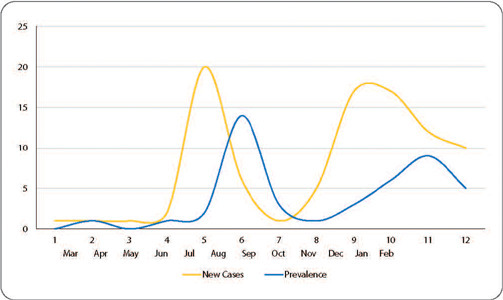
-
ORIGINAL ARTICLE01-10-2024
Morbidity and factors associated with frailty in post-COVID-19 elderly patients attended at a reference center
Revista Brasileira de Enfermagem. 2024;77:e20230454
Abstract
ORIGINAL ARTICLEMorbidity and factors associated with frailty in post-COVID-19 elderly patients attended at a reference center
Revista Brasileira de Enfermagem. 2024;77:e20230454
DOI 10.1590/0034-7167-2023-0454
Views0See moreABSTRACT
Objective:
To assess the morbidity profile and identify factors associated with frailty syndrome in post-COVID-19 elderly patients treated at the only Reference Center for Elderly Health Care in northern Minas Gerais.
Methods:
This is a case series study, utilizing the Clinical-Functional Vulnerability Index-20 (CFVI-20) and Comprehensive Geriatric Assessment (CGA) to characterize and evaluate the health condition of the group. To define the variables associated with frailty, a multivariate analysis was conducted.
Results:
The study included 204 elderly individuals, with a predominance of females (63.7%). The variables associated with frailty were cognitive impairment (OR: 2.95; 95% CI: 1.12-7.80; p=0.029), the presence of five or more comorbidities (OR: 11.55; 95% CI: 2.22-60.01; p=0.004), and impairment in instrumental activities of daily living (OR: 41.97; 95% CI: 5.47-321.93; p<0.001).
Conclusions:
The results of this study highlight the need for a well-established and prepared coordination of integrated care to meet the demands of the post-COVID-19 elderly population.
-
ORIGINAL ARTICLE01-10-2024
Nursing care management strategies to address the COVID-19 pandemic
Revista Brasileira de Enfermagem. 2024;77:e20230254
Abstract
ORIGINAL ARTICLENursing care management strategies to address the COVID-19 pandemic
Revista Brasileira de Enfermagem. 2024;77:e20230254
DOI 10.1590/0034-7167-20230254
Views0See moreABSTRACT
Objective:
To characterize nursing care management strategies for addressing the COVID-19 pandemic.
Method:
A descriptive, qualitative study conducted with 22 nurse professionals at a University Hospital in Southern Brazil. Data collection through interviews in June and August 2021, analyzed according to Bardin’s Content Analysis and the theoretical framework of complex thinking.
Results:
The identified strategies were organized into four categories: Reorganization of health services; People management and emergency admission; Multiprofessional articulation; and Bedside nursing care.
Final Considerations:
Professional performance revealed a complex interplay between leadership and care management practices, even in the face of working condition restrictions, and were understood as crucial in the pandemic scenario.
-
REVIEW01-01-2018
Patient safety and infection control: bases for curricular integration
Revista Brasileira de Enfermagem. 2018;71(3):1170-1177
Abstract
REVIEWPatient safety and infection control: bases for curricular integration
Revista Brasileira de Enfermagem. 2018;71(3):1170-1177
DOI 10.1590/0034-7167-2017-0314
Views0See moreABSTRACT
Objective:
To analyze curricular integration between teaching of patient safety and good infection prevention and control practices.
Method:
Integrative review, designed to answer the question: “How does curricular integration of content about ‘patient safety teaching’ and content about ‘infection prevention and control practices’ occur in undergraduate courses in the health field?”. The following databases were searched for primary studies: CINAHL, LILACS, ScienceDirect, Web of Science, Scopus, Europe PMC and MEDLINE.
Results:
The final sample consisted of 13 studies. After content analysis, primary studies were grouped into two subject categories: “Innovative teaching practices” and “Curricular evaluation.
Conclusion:
Patient safety related to infection prevention and control practices is present in the curriculum of health undergraduate courses, but is not coordinated with other themes, is taught sporadically, and focuses mainly on hand hygiene.
-
REVIEW01-01-2018
Dry Eye Syndrome in Intensive Care Units: a concept analysis
Revista Brasileira de Enfermagem. 2018;71(3):1162-1169
Abstract
REVIEWDry Eye Syndrome in Intensive Care Units: a concept analysis
Revista Brasileira de Enfermagem. 2018;71(3):1162-1169
DOI 10.1590/0034-7167-2016-0582
Views0See moreABSTRACT
Purpose:
To analyse the concept of Dry Eye Syndrome in patients admitted to Intensive Care Units (ICU).
Method:
This is a concept analysis, according to Walker’s and Avant’s method, conducted using an integrative review, through search in the database. Science Direct, Scopus, Cinahl, Pubmed, Lilacs, Cochrane and Web of Science. The following keywords were used: “Keratoconjuntivite Sicca”, “Risk Factors”, “Dry eye Syndromes” and “Intensive Care Units”. After selection, 85 articles have been kept.
Results:
Antecedents found: age, lagophthalmos, environmental factors, use of medications, systemic diseases, mechanical ventilation and eye surgeries. Attributes: Tear Break-up Time < 10 s, Schirmer’s test I < 10 mm, Schirmer’s test II < 5 mm and signs and symptoms. Consequents: eye damage and discomfort; unstable vision. The Model Case and the Contrary Case were used to illustrate it.
Conclusion:
The research provided clarification of the concept and consequent understanding of the Dry Eye Syndrome, which is preventable especially in ICU.

-
REVIEW01-01-2018
Institutional violence during the parturition process in Brazil: integrative review
Revista Brasileira de Enfermagem. 2018;71(3):1152-1161
Abstract
REVIEWInstitutional violence during the parturition process in Brazil: integrative review
Revista Brasileira de Enfermagem. 2018;71(3):1152-1161
DOI 10.1590/0034-7167-2017-0238
Views0See moreABSTRACT
Objective:
To identify the types of institutional violence of childbirth reported by the woman, the birth companion and health professionals.
Method:
Integrative review that analyzed 33 articles in the LILACS, BDENF, INDEXPSI, regional SciELO, Scopus, Web Of Science and PubMed databases.
Results:
Women were the main violence rapporteur, with predominance of the psychological type. Precarious infrastructure and the imposition of professional decisions were identified by the companion as violence. For health professionals, performing procedures without consent does not characterize violence, but guarantees childbirth security.
Final considerations:
The most common types of violence in Brazilian maternity hospitals are psychological, physical and structural. Most of the time, violence is reported by women, although professionals also perceive and admit its perpetuation.
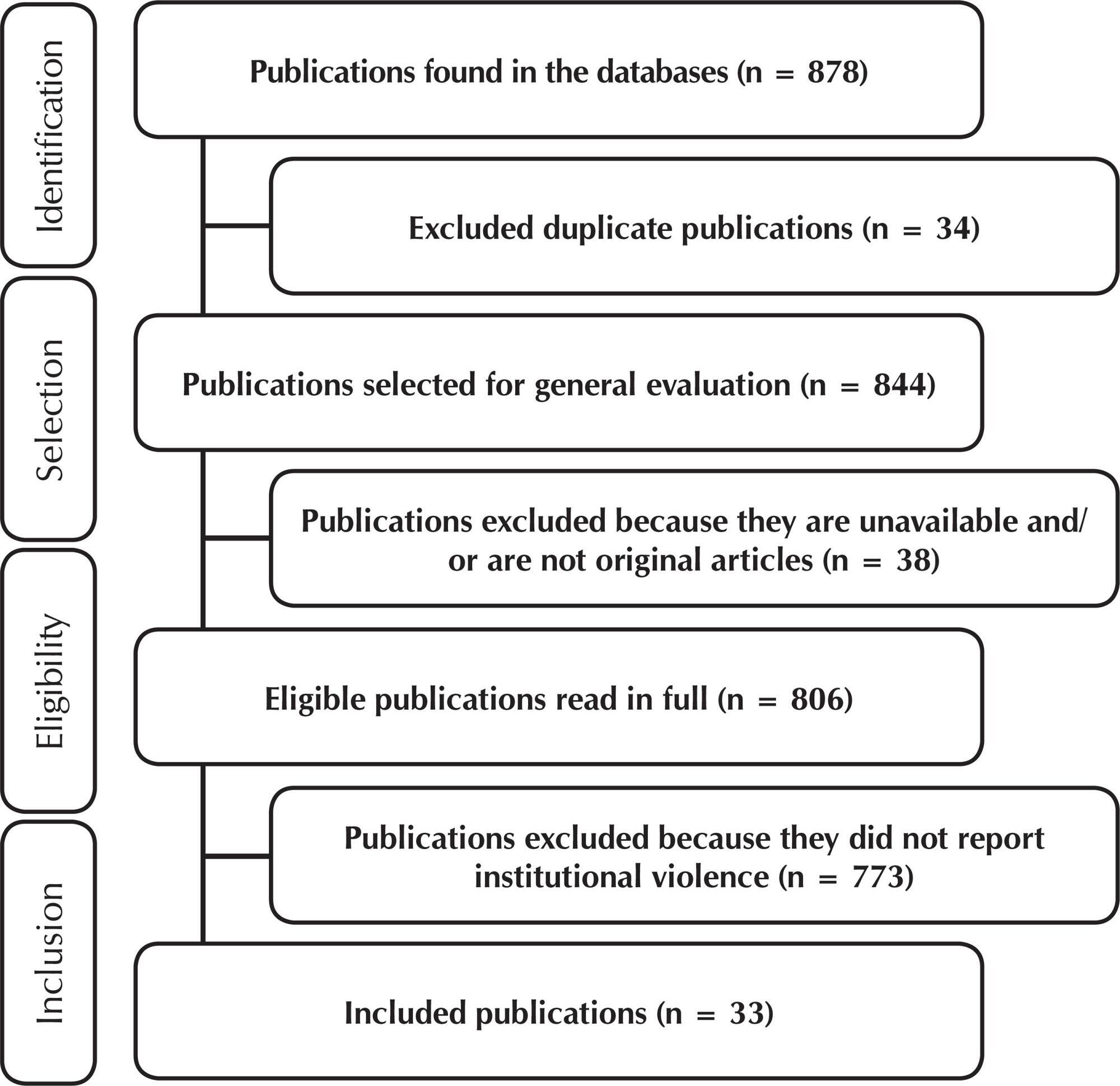
-
RESEARCH01-01-2018
Education practices: research-action with nurses of Family Health Strategy
Revista Brasileira de Enfermagem. 2018;71(3):1144-1151
Abstract
RESEARCHEducation practices: research-action with nurses of Family Health Strategy
Revista Brasileira de Enfermagem. 2018;71(3):1144-1151
DOI 10.1590/0034-7167-2017-0284
Views0ABSTRACT
Objective:
to identify the factors that determine the implementation of educational practices of health promotion and to construct proposals to implement the educational actions of the nurses of the Family Health Units (FHU).
Method:
research-action in which individual interviews and focus group were conducted, with 17 nurses from 12 FHU in the city of Cruzeiro do Sul, Acre state, Brazil. The results were organized by the thematic analysis method.
Results:
the thematic units emerged from the analysis: dichotomy between knowledge and doing in the production of care and health; the nurse’s qualification for educational practices; and conditions favorable to health education practices.
Conclusion:
the thematic analysis showed that the educational practice is hampered by the high demand for care in the unit, lack of physical structure and professional qualification for health education. In the action phase, nurses and local managers agreed on actions to improve the quality of educational practices.
Keywords:Collective HealthCommunity Health NursingFamily HealthHealth EducationPublic Health NursingSee more -
RESEARCH01-01-2018
Qualification of the family caregiver to the application of the Educational Technology in Health
Revista Brasileira de Enfermagem. 2018;71(3):1135-1143
Abstract
RESEARCHQualification of the family caregiver to the application of the Educational Technology in Health
Revista Brasileira de Enfermagem. 2018;71(3):1135-1143
DOI 10.1590/0034-7167-2017-0163
Views0See moreABSTRACT
Objective:
To evaluate the changes in the participation of the family caregiver in the treatment of the hypertensive person with the application of the Educational Technology in Health (ETH).
Method:
Participant research carried out in a Primary Health Care Unit with 11 family caregivers (FC). The ETH was elaborated based on health education and applied in ten meetings between June and August 2016. We organized the results into categories.
Results:
FCs experienced learning experiences through the exchange of information, socialization of experiences, and linkage establishments. The FCs were encouraged to share their doubts and experiences, so that, supported by listening to the professional, they felt welcomed and determined to fulfill their role with hypertensive relatives.
Final considerations:
The changes that have taken place have been highlighted in the learning of FCs and their commitment to family and self-care, as well as to the conviction that the family environment is indicated to make these changes effective.
-
RESEARCH01-01-2018
Discursive archaeology: constituting knowledge of militant nurses in trade associations
Revista Brasileira de Enfermagem. 2018;71(3):1128-1134
Abstract
RESEARCHDiscursive archaeology: constituting knowledge of militant nurses in trade associations
Revista Brasileira de Enfermagem. 2018;71(3):1128-1134
DOI 10.1590/0034-7167-2017-0277
Views0See moreABSTRACT
Objective:
To analyze the constituting knowledge of militant nurses in trade associations.
Method:
Historical research, based on the oral history method, with a qualitative approach carried out with 11 nurses who are/were militants for professional issues since the 1980s in the state of Bahia. The data collected through semi-structured interviews were organized in the software n-vivo 10 and analyzed based on dialectical hermeneutics.
Results:
We identified pedagogical, administrative, public health, sociological, and trade union background knowledge as constituent of militant individuals.
Final considerations:
The constituting knowledge of militant nurses are inscribed in the Social Sciences, distanced from biomedical knowledge and power, pointing at ways for structuring nursing curricula. We identified the Brazilian Association of Nursing as a space for political formation.
-
RESEARCH01-01-2018
Coordination of health care with the community in the clinical management of tuberculosis
Revista Brasileira de Enfermagem. 2018;71(3):1122-1127
Abstract
RESEARCHCoordination of health care with the community in the clinical management of tuberculosis
Revista Brasileira de Enfermagem. 2018;71(3):1122-1127
DOI 10.1590/0034-7167-2017-0255
Views0See moreABSTRACT
Objective:
determine the coordination of Primary Health Care with community resources in the clinical management of tuberculosis.
Method:
descriptive study, of quantitative approach, with participation of one hundred health professionals. Part of a questionnaire was used in evaluating local institutional capacity for the model of chronic conditions care, adapted for tuberculosis care.
Results:
the coordination between health units, individuals with tuberculosis, and community organizations; the partnerships between institutions and local health councils/committees showed limited capacity. On the other hand, the component for the participation of the Community Health Agent presented more favorable capacity.
Conclusion:
the municipality has unfavorable capacity for coordination of health units and the community. It is reinforced the need to promote these coordinations in search of symptomatic cases in the communities, in the directly observed treatment, and in promoting the association between different social actors.
Search
Search in:
Nuvem de Tags
Aged (144) Atenção Primária à Saúde (239) COVID-19 (104) Cuidados de Enfermagem (269) Educação em Enfermagem (151) Educação em Saúde (139) Enfermagem (930) Estudos de Validação (131) Health Education (144) Idoso (208) Mental Health (149) Nursing (987) Nursing Care (306) Patient Safety (151) Primary Health Care (284) Qualidade de Vida (104) Quality of Life (106) Saúde Mental (145) Segurança do Paciente (150) Validation Studies (108)




